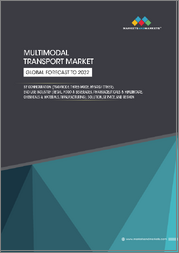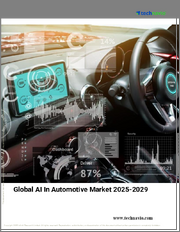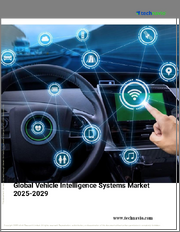
|
시장보고서
상품코드
1636835
자동차 AI 수리 서비스 시장 규모, 점유율, 성장 분석 : 서비스 유형별, 기술별, 도입별, 차종별, 최종사용자별, 지역별 - 산업 예측(2025-2032년)Automotive AI Repair Services Market Size, Share, Growth Analysis, By Service Type (Diagnosis, Predictive Maintenance), By Technology (Machine learning, Deep Learning), By Deployment, By Vehicle Type, By End User, By Region - Industry Forecast 2025-2032 |
||||||
세계의 자동차 AI 수리 서비스 시장 규모는 2023년에 6억 8,400만 달러로 평가되며, 2024년에는 7억 9,754만 달러에서 2032년에는 27억 2,485만 달러로 성장하며, 예측 기간(2025-2032년)의 CAGR은 16.6%로 성장할 전망입니다.
자동차 수리 상황은 자동차의 복잡성이 증가함에 따라 전문적인 진단 툴을 필요로 하는 최신 시스템으로 진화하고 있습니다. 이러한 복잡성은 정비사가 문제를 파악하고 적시에 수리를 수행하는 데 어려움을 겪을 수 있습니다. 그러나 자동차 서비스에 AI를 통합하면 정확한 진단과 예측 유지보수를 가능하게 하고, 궁극적으로 다운타임과 비용을 절감할 수 있는 혁신적인 솔루션을 제공할 수 있습니다. 전기자동차의 급속한 보급과 화석연료 탈피에 따른 규제 변화로 인해 자동차 AI 수리 서비스에 대한 수요가 증가함에 따라 기업은 개별 요구에 맞는 AI 솔루션을 개발할 수 있는 큰 기회를 얻게 되었습니다. 그러나 AI 기술에 대한 초기 투자는 중소기업의 진입장벽이 될 수 있는 반면, AI와 IoT 및 블록체인 기술과의 시너지를 통해 수리 효율성과 서비스 품질을 향상시킬 수 있는 새로운 길이 열릴 수 있습니다.
목차
서론
- 조사의 목적
- 조사 범위
- 정의
조사 방법
- 정보 조달
- 2차 데이터와 1차 데이터 방법
- 시장 규모 예측
- 시장의 전제조건과 제한
개요
- 세계 시장 전망
- 공급과 수요의 동향 분석
- 부문별 기회 분석
시장 역학과 전망
- 시장 개요
- 시장 규모
- 시장 역학
- 촉진요인과 기회
- 억제요인과 과제
- Porter의 산업 분석
주요 시장 인사이트
- 주요 성공 요인
- 경쟁의 정도
- 주요 투자 기회
- 시장 에코시스템
- 시장의 매력 지수(2024년)
- PESTEL 분석
- 거시경제 지표
- 밸류체인 분석
- 가격 분석
- 사례 연구
- 규제 상황
자동차 AI 수리 서비스 시장 규모 : 서비스 유형별과 CAGR(2025-2032년)
- 시장 개요
- 진단
- 예지보전
- 수리
- 기타
자동차 AI 수리 서비스 시장 규모 : 기술별과 CAGR(2025-2032년)
- 시장 개요
- 기계학습
- 딥러닝
- 자연언어처리
- 컴퓨터 비전
- 기타
자동차 AI 수리 서비스 시장 규모 : 도입별과 CAGR(2025-2032년)
- 시장 개요
- 클라우드 기반
- 온프레미스
- 하이브리드
자동차 AI 수리 서비스 시장 규모 : 차종별과 CAGR(2025-2032년)
- 시장 개요
- 승용차
- 상용차
- 기타
자동차 AI 수리 서비스 시장 규모 : 최종사용자별과 CAGR(2025-2032년)
- 시장 개요
- 독립계 수리 공장
- OEM(Original Equipment Manufacturers)
- 기타
자동차 AI 수리 서비스 시장 규모와 CAGR(2025-2032년)
- 북미
- 미국
- 캐나다
- 유럽
- 독일
- 스페인
- 프랑스
- 영국
- 이탈리아
- 기타 유럽 지역
- 아시아태평양
- 중국
- 인도
- 일본
- 한국
- 기타 아시아태평양
- 라틴아메리카
- 브라질
- 기타 라틴아메리카 지역
- 중동 및 아프리카
- GCC 국가
- 남아프리카공화국
- 기타 중동 및 아프리카
경쟁 정보
- 상위 5사의 비교
- 주요 기업의 시장 포지셔닝(2024년)
- 주요 시장 기업이 채택한 전략
- 시장의 최근 동향
- 기업의 시장 점유율 분석(2024년)
- 주요 기업의 기업 개요
- 회사 개요
- 제품 포트폴리오 분석
- 부문별 점유율 분석
- 매출의 전년대비 비교(2022-2024년)
주요 기업 개요
- Bosch(Germany)
- Continental AG(Germany)
- Denso Corporation(Japan)
- Delphi Automotive(UK)(now Aptiv PLC)
- ZF Friedrichshafen AG(Germany)
- Aisin Seiki Co. Ltd.(Japan)
- Hitachi Automotive Systems(Japan)
- Lear Corporation(US)
- Hyundai Mobis Co., Ltd.(South Korea)
- Robert Bosch GmbH(Germany)
결론과 권장사항
KSA 25.02.19Global Automotive AI Repair Services Market size was valued at USD 684.0 million in 2023 and is poised to grow from USD 797.54 million in 2024 to USD 2724.85 million by 2032, growing at a CAGR of 16.6% during the forecast period (2025-2032).
The automotive repair landscape is evolving with the rising complexity of vehicles, driven by modern systems that necessitate specialized diagnostic tools. This intricacy can pose challenges for mechanics in identifying issues and executing timely repairs. However, the integration of AI into auto services offers a transformative solution, enabling precise diagnostics and predictive maintenance, ultimately reducing downtime and costs. As the demand for Automotive AI Repair Services grows, largely fueled by the surge in electric vehicle adoption and regulatory shifts away from fossil fuels, businesses are presented with a significant opportunity to develop tailored AI solutions. Yet, the initial investment in AI technologies may present entry barriers for smaller firms, while the synergy of AI with IoT and blockchain technologies could open new avenues for enhancing repair efficiency and service quality.
Top-down and bottom-up approaches were used to estimate and validate the size of the Global Automotive Ai Repair Services market and to estimate the size of various other dependent submarkets. The research methodology used to estimate the market size includes the following details: The key players in the market were identified through secondary research, and their market shares in the respective regions were determined through primary and secondary research. This entire procedure includes the study of the annual and financial reports of the top market players and extensive interviews for key insights from industry leaders such as CEOs, VPs, directors, and marketing executives. All percentage shares split, and breakdowns were determined using secondary sources and verified through Primary sources. All possible parameters that affect the markets covered in this research study have been accounted for, viewed in extensive detail, verified through primary research, and analyzed to get the final quantitative and qualitative data.
Global Automotive Ai Repair Services Market Segmental Analysis
Global Automotive AI Repair Services Market is segmented by Service Type, Technology, Deployment, Vehicle Type, End User and Region. Based on Service Type, the market is segmented into Diagnosis, Predictive Maintenance, Repairs and Others. Based on Technology, the market is segmented into Machine learning, Deep Learning, Natural Language Processing,computer vision, and Others. Based on Deployment, the market is segmented into Cloud-Based, On-Premise and Hybrid. Based on Vehicle Type, the market is segmented into Passenger cars, Commercial Vehicles and Others. Based on End User, the market is segmented into Independent Repair Shops, Original Equipment Manufacturers (OEMs) and Others. Based on Region, the market is segmented into North America, Europe, Asia Pacific, Latin America and Middle East & Africa.
Driver of the Global Automotive Ai Repair Services Market
The Global Automotive AI Repair Services market is significantly influenced by the increasing focus on environmental sustainability and responsibility. As consumers become more environmentally aware, there is a rising demand for eco-friendly repair and maintenance solutions. Automotive repair shops that offer sustainable services, such as electric vehicle repairs and recycling options for car parts, are increasingly attracting environmentally-conscious customers. This alignment with eco-friendly practices not only fulfills consumer expectations but also gives these repair establishments a competitive advantage in the market, further accelerating the growth of the automotive AI repair services sector.
Restraints in the Global Automotive Ai Repair Services Market
One significant constraint faced by the Global Automotive AI Repair Services market is the elevated costs associated with adopting AI technology. The substantial initial investment required for acquiring AI hardware and software, coupled with the ongoing maintenance expenses, poses a considerable financial burden. As a result, these high costs can deter many businesses from integrating AI repair services into their operations. This reluctance to invest in advanced technology may hinder market growth and limit the potential for widespread adoption among various automotive repair providers, thereby slowing progress in this innovative sector.
Market Trends of the Global Automotive Ai Repair Services Market
The Global Automotive AI Repair Services market is witnessing significant growth fueled by the increasing incorporation of preventative maintenance tools that leverage advanced AI and machine learning technologies. These predictive maintenance solutions analyze real-time data from vehicles to accurately foresee maintenance needs, allowing repair facilities to intervene proactively. This trend not only enhances operational efficiency by reducing vehicle downtime but also lowers repair expenses, making it an attractive proposition for both service providers and vehicle owners. As more automotive companies adopt these data-driven strategies, the market is poised for substantial expansion, driven by the demand for improved reliability and reduced operational costs in automotive maintenance.
Table of Contents
Introduction
- Objectives of the Study
- Scope of the Report
- Definitions
Research Methodology
- Information Procurement
- Secondary & Primary Data Methods
- Market Size Estimation
- Market Assumptions & Limitations
Executive Summary
- Global Market Outlook
- Supply & Demand Trend Analysis
- Segmental Opportunity Analysis
Market Dynamics & Outlook
- Market Overview
- Market Size
- Market Dynamics
- Drivers & Opportunities
- Restraints & Challenges
- Porters Analysis
- Competitive rivalry
- Threat of substitute
- Bargaining power of buyers
- Threat of new entrants
- Bargaining power of suppliers
Key Market Insights
- Key Success Factors
- Degree of Competition
- Top Investment Pockets
- Market Ecosystem
- Market Attractiveness Index, 2024
- PESTEL Analysis
- Macro-Economic Indicators
- Value Chain Analysis
- Pricing Analysis
- Case Studies
- Regulatory Landscape
Global Automotive AI Repair Services Market Size by Service Type & CAGR (2025-2032)
- Market Overview
- Diagnosis
- Predictive Maintenance
- Repairs
- Others
Global Automotive AI Repair Services Market Size by Technology & CAGR (2025-2032)
- Market Overview
- Machine learning
- Deep Learning
- Natural Language Processing
- Computer Vision
- Others
Global Automotive AI Repair Services Market Size by Deployment & CAGR (2025-2032)
- Market Overview
- Cloud-Based
- On-Premise
- Hybrid
Global Automotive AI Repair Services Market Size by Vehicle Type & CAGR (2025-2032)
- Market Overview
- Passenger cars
- Commercial Vehicles
- Others
Global Automotive AI Repair Services Market Size by End User & CAGR (2025-2032)
- Market Overview
- Independent Repair Shops
- Original Equipment Manufacturers (OEMs)
- Others
Global Automotive AI Repair Services Market Size & CAGR (2025-2032)
- North America (Service Type, Technology, Deployment, Vehicle Type, End User)
- US
- Canada
- Europe (Service Type, Technology, Deployment, Vehicle Type, End User)
- Germany
- Spain
- France
- UK
- Italy
- Rest of Europe
- Asia Pacific (Service Type, Technology, Deployment, Vehicle Type, End User)
- China
- India
- Japan
- South Korea
- Rest of Asia-Pacific
- Latin America (Service Type, Technology, Deployment, Vehicle Type, End User)
- Brazil
- Rest of Latin America
- Middle East & Africa (Service Type, Technology, Deployment, Vehicle Type, End User)
- GCC Countries
- South Africa
- Rest of Middle East & Africa
Competitive Intelligence
- Top 5 Player Comparison
- Market Positioning of Key Players, 2024
- Strategies Adopted by Key Market Players
- Recent Developments in the Market
- Company Market Share Analysis, 2024
- Company Profiles of All Key Players
- Company Details
- Product Portfolio Analysis
- Company's Segmental Share Analysis
- Revenue Y-O-Y Comparison (2022-2024)
Key Company Profiles
- Bosch (Germany)
- Company Overview
- Business Segment Overview
- Financial Updates
- Key Developments
- Continental AG (Germany)
- Company Overview
- Business Segment Overview
- Financial Updates
- Key Developments
- Denso Corporation (Japan)
- Company Overview
- Business Segment Overview
- Financial Updates
- Key Developments
- Delphi Automotive (UK) (now Aptiv PLC)
- Company Overview
- Business Segment Overview
- Financial Updates
- Key Developments
- ZF Friedrichshafen AG (Germany)
- Company Overview
- Business Segment Overview
- Financial Updates
- Key Developments
- Aisin Seiki Co. Ltd. (Japan)
- Company Overview
- Business Segment Overview
- Financial Updates
- Key Developments
- Hitachi Automotive Systems (Japan)
- Company Overview
- Business Segment Overview
- Financial Updates
- Key Developments
- Lear Corporation (US)
- Company Overview
- Business Segment Overview
- Financial Updates
- Key Developments
- Hyundai Mobis Co., Ltd. (South Korea)
- Company Overview
- Business Segment Overview
- Financial Updates
- Key Developments
- Robert Bosch GmbH (Germany)
- Company Overview
- Business Segment Overview
- Financial Updates
- Key Developments



















